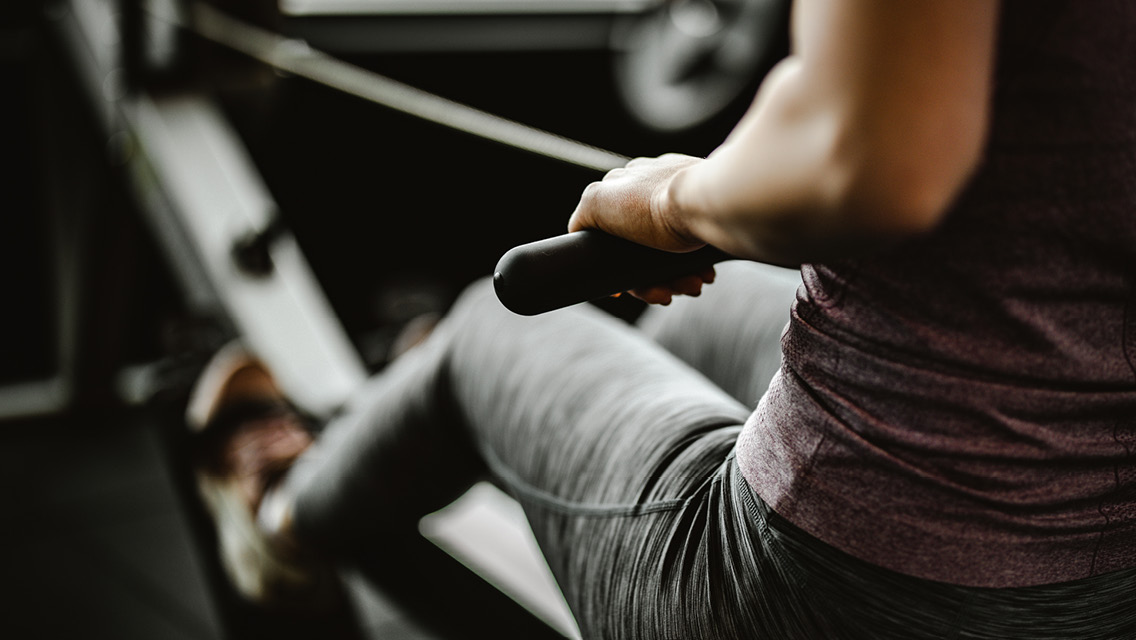You’ve probably heard plenty of folks bemoan their “slow” metabolism, and some lucky others credit their strong physique to a “fast” metabolism. But what exactly does this mean? And what does it take to make yours faster?
Metabolism refers to the process by which cells turn fuel into energy. Metabolism is regulated by a variety of factors, including your genetics, hormonal profile, activity level and more. Your rate of metabolism also changes in response to fitness training.
Tracking your metabolism with a heart-rate monitor provides a powerful tool for optimizing the physiological results of your training. By regulating your level of activity with a heart-rate monitor, you can incrementally adjust your metabolism, making it more efficient. You can also determine what fuel your muscle cells consume during a given workout – fat, carbohydrates or glucose – and this can have a powerful impact on how quickly you burn off unwanted weight.
Choose Your Fuel
The type of fuel your body consumes depends on the rate at which your body is demanding energy. For example, sitting and reading demands very little energy, so right now (unless you are reading this on a treadmill) your body is probably using a clean, slow-burning metabolic fuel: fat. Get up and sprint, and you’ll stop burning adipose tissue altogether. But you will burn a lot of calories in the form of carbohydrate and glucose. There’s the rub: You want to burn maximum calories and maximum fat. And you probably don’t want to work harder than you have to.
How? The trick here is to precisely calibrate your level of exercise so that you can maximize fat consumption without racing the engines.
Unlike a car, your body uses three types of fuel. At the lowest level of activity, your cells consume fat. As you step up the intensity, your muscles begin relying on carbohydrates. Increase the demands dramatically, and glucose provides the turbocharge needed for quick bursts of activity such as lifting weights or jumping out of the way of an oncoming train. (See “All About Your Metabolic Energy Systems” to learn how each system works, and how to make the most of them during your workout.)
Although exercising intensely yields many physiological benefits and should remain an important component in your fitness regimen, it’s not necessarily the best means of losing weight. For one thing, it tends to make you hungry for carbs and sugar because your body only holds a limited store of these fuels – about 2,000 calories. Once you use these up in a few hour’s worth of intense exercise, your body demands replenishment, which makes it hard to stay on a low-carb, low-calorie diet.
In contrast, most of us carry enough fat on board to fuel several week’s worth of activity: about 100,000 calories on average. Exercising in the “fat-burning” zone generally doesn’t produce the same level of cravings because your body knows there’s plenty of fuel left in your tank.
But don’t sit back and relax just yet. Reducing fot requires commitment. To get optimal fat loss, you’ll have to work out at the mid to high end of your fat-burning metabolic zone for extended periods of time – ranging from 45 to 90 minutes – three or four times a week.
Learn to Burn
If you walk slowly on the treadmill for 20 minutes, you’ll certainly burn some fat, but very little. At low rates of activity, you must work a lot longer to benefit, because you’re simply not burning much caloric energy.
Those who hate working out often make the mistake of ambling along at a relaxing, too-slow pace. On the other hand, those who like to work out – and also overambitious beginners – often make the mistake of working out too hard. They want to “feel like they did something,” so they push it. A lot of us also quit too soon, bored of the treadmill and eager to move on to a more exciting sport of choice.
This is where a heart monitor – combined with an appropriate exercise prescription – can come in very handy. Once you understand how to use it, a heart-rate monitor helps you determine the level of exertion that catalyzes your body’s highest possible level of fat consumption – the point just before your cells switch to faster-burning fuels.
A monitor can also provide important information for other workout goals, such as improved cardiovascular fitness, endurance and speed. Here we focus primarily on one thing: effectively burning unwanted fat.
Fat-Burning Prescription
If you have access to metabolic-testing equipment at your health club, a sports medicine clinic or local university, you can obtain an individualized measure of the pace your heart beats when your body burns the most fat. Once you know your score, it’s easy to maximize your fat loss.
Until recently, only elite athletes and researchers could get their hands on the sophisticated equipment required to measure metabolism, but this has changed.
Richard Diaz, programs director of the USA Sports Medicine Clinic, was among the first to make metabolic testing available to the public. Diaz has tested thousands of elite athletes and prescribed heart-rate training programs for improved endurance and speed, but he’s also coached the decidedly unathletic.
He teamed up with VH1 to select four overweight women to participate in a 12-week makeover. This experiment aired on the network’s “Rock Bodies: From Flab to Fab,” a television special that traced the progress of four ordinary women who were given access to the army of trainers, nutritional coaches and fashion consultants usually reserved for well-heeled athletes and movie stars.
The first step in the makeover involved determining each woman’s metabolic status. Diaz had the participants run on a treadmill while he monitored their burn rate using a sophisticated breath analyzer. By correlating their heartbeats with the underlying metabolic energy system at work, Diaz was able to prescribe individualized heart-rate targets for the women to use as a guide to maximizing fat loss while performing their aerobic workouts.
Finding Your Beat
Until you find these services in your area, Diaz recommends using the standard formulas prescribed in heart-rate charts. His favorite, for simplicity, comes from training guru Phillip Maffetone, who recommends subtracting your age from 180 (regardless of sex) to determine your anaerobic threshold, which roughly corresponds with your upper-level fat-burning zone. “I’ve tested thousands of people and Phil’s formula works for 75 percent,” says Diaz, excluding those at the upper and lower extremes of the fitness spectrum.
The aerobic threshold represents the point at which your body shifts from mostly fat-burning to primarily carbs-consuming mode. Since the fat-burning threshold varies between individuals, no formula can provide a truly precise assessment. So Diaz recommends working within 10 beats of the predictive maximum.
For example, using the Maffetone formula, a 35-year-old would subtract his or her age from 180 to yield a threshold level of 145 beats per minute. Diaz would then recommend that person work in a range from 135 to 145 beats, but not in excess of the upper limit. Even if this doesn’t precisely optimize your workout, you’ll be pretty close.
You can find many other prescriptive formulas for figuring your fat-burning zone, some adjusted for resting heart rate, others taking into account age, gender and level of fitness. They all produce roughly the same results with about the same 70 percent accuracy (not great, but better than nothing).
Unless you have testing equipment available, Diaz suggests going with a simple formula because you’ll have no way of knowing if any formula-based program is working until you try it for about a month anyway. Even if you’re off a few points, you’ll still make progress. However, for maximum workout efficiency, an honest-to-goodness metabolic assessment is always your best bet.
Tough Tempo
For the already-fit, long bouts of aerobic exercise at moderate intensity can be downright tedious. They just don’t provide that sense of accomplishment that comes from a sweat-inducing workout. Diaz has heard this complaint many times and has come to expect it. After a week at a prescribed intensity, he says, most people harp about not feeling like they’re working hard enough.
Still, Diaz insists you stay on the “medicine” for at least three weeks. “After a month you’ll be hooked for life,” he claims. But don’t get the idea this workout is easy. It still requires discipline. At the top end of your fat-burning zone you’ll have to spend 45 to 90 minutes per aerobic training session, three or four times a week, to achieve appreciable results.
And appreciable they are. Consider that the gals on “Rock Bodies: From Flab to Fab” lost an average of 25 pounds of fat – not water or muscle – in 12 weeks.
Prescription for Fat Loss
To achieve the kind of results these women did, Diaz recommends an 80/20 training routine, spending 80 percent of your time on fat loss and the remainder on conditioning (see below).
He compares this training profile to a marathoner’s off-season schedule, when the runner trains at a slower pace to build a base of aerobic endurance that will take him or her through the long runs ahead. Although his or her focus remains on building endurance, at least 20 percent of the marathoner’s training still goes into maintaining speed and a high level of cardiovascular conditioning, using a technique known as interval training.
Interval training entails alternating between short bouts of high intensity and intervals of recovery. This forces your heart rate to rise as oxygen demands increase and metabolic waste accumulates in your muscles, and then to drop as you relax the pace and allow your body to sweep out the metabolic furnaces.
It’s this seesaw effect that provides excellent cardiovascular conditioning and enhances your metabolic function. In time, it can improve your resting metabolism and you’ll find you have more energy and less stress. Theoretically you’ll also be burning slightly more fat while resting.
Perhaps the most important benefit of training this way is that as you become more fit, you’ll find that managing your weight becomes easier overall.
Want to learn more about using heart-rate training for weight loss and/or improved fitness? Check out a good heart-rate training book like Fit and Fat: The Eight Week Heart Zones Program by Sally Edwards (you can also visit her Web site www.heartzones.com for a wealth of solid training advice and some very handy calculation tools). Then strap on the heart-rate monitor and a headset, turn up the tunes and get ready to groove in your own personal fat-burning zone.
The 80/20 Fat-Burning Prescription
Here’s how your training might look when you’re trying to burn fat:
- Three days a week you run, cycle or row for 45 to 90 minutes at your target sub-threshold rate (180 beats per minute minus your age). Work within 10 beats of that limit, but don’t exceed it. This can become grueling, but there’s no need to make it harder by remaining on one piece of equipment.
- Jump around, switching from treadmill to recumbent bike, Transport or step machine. As long as you keep your heart rate on target, you’re accomplishing your goal.
- Two days a week, stomp on the metabolic accelerator to clear the lines and blow off the cobwebs. The best way to do this is interval training. Once again, you’ll have to rely on a heart-rate chart, your calculator and a heart-rate monitor.
For the sake of simplicity, let’s do the math the easy way:
Deduct your age from 220. This yields an approximate measure of your maximum, age-adjusted heart rate. Multiply this number by 85 percent, and you have the upper limit of your interval training. In the case of a 35-year-old, this equation yields 157 beats per minute.
Jump on your favorite aerobic device and warm up for about five minutes, or until your heart rate reaches approximately 20 beats below your aerobic-threshold level (in our example, 137).
When you have completed your warm-up, boost the intensity by either speeding up or raising the grade. Observe your heart working harder until you reach your target upper-level heart rate (in our example, 157).
Remain at this level for 30 seconds and then drop the intensity gradually until your heart returns to its pre-interval pace.
Then immediately reverse the process and rev up the motor again.
Start with three to four intervals and work your way up to 10.
This article originally appeared as “Pace Yourself” in the January/February 2004 issue of Experience Life.




This Post Has 0 Comments